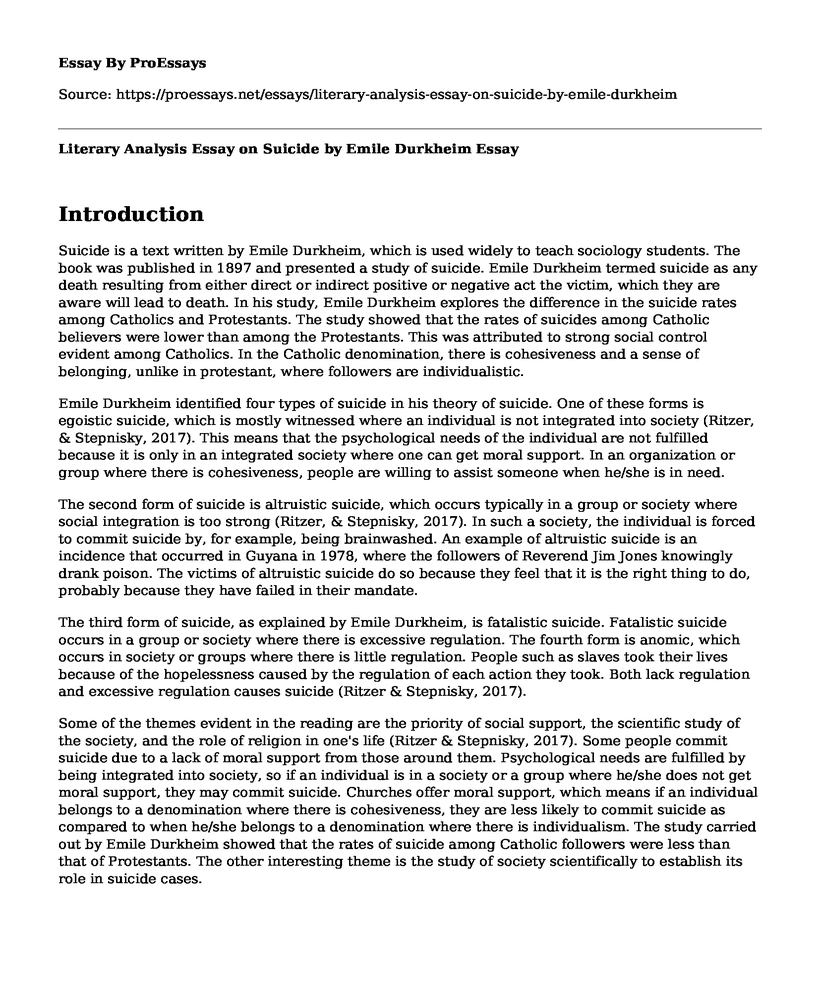Introduction
Suicide is a text written by Emile Durkheim, which is used widely to teach sociology students. The book was published in 1897 and presented a study of suicide. Emile Durkheim termed suicide as any death resulting from either direct or indirect positive or negative act the victim, which they are aware will lead to death. In his study, Emile Durkheim explores the difference in the suicide rates among Catholics and Protestants. The study showed that the rates of suicides among Catholic believers were lower than among the Protestants. This was attributed to strong social control evident among Catholics. In the Catholic denomination, there is cohesiveness and a sense of belonging, unlike in protestant, where followers are individualistic.
Emile Durkheim identified four types of suicide in his theory of suicide. One of these forms is egoistic suicide, which is mostly witnessed where an individual is not integrated into society (Ritzer, & Stepnisky, 2017). This means that the psychological needs of the individual are not fulfilled because it is only in an integrated society where one can get moral support. In an organization or group where there is cohesiveness, people are willing to assist someone when he/she is in need.
The second form of suicide is altruistic suicide, which occurs typically in a group or society where social integration is too strong (Ritzer, & Stepnisky, 2017). In such a society, the individual is forced to commit suicide by, for example, being brainwashed. An example of altruistic suicide is an incidence that occurred in Guyana in 1978, where the followers of Reverend Jim Jones knowingly drank poison. The victims of altruistic suicide do so because they feel that it is the right thing to do, probably because they have failed in their mandate.
The third form of suicide, as explained by Emile Durkheim, is fatalistic suicide. Fatalistic suicide occurs in a group or society where there is excessive regulation. The fourth form is anomic, which occurs in society or groups where there is little regulation. People such as slaves took their lives because of the hopelessness caused by the regulation of each action they took. Both lack regulation and excessive regulation causes suicide (Ritzer & Stepnisky, 2017).
Some of the themes evident in the reading are the priority of social support, the scientific study of the society, and the role of religion in one's life (Ritzer & Stepnisky, 2017). Some people commit suicide due to a lack of moral support from those around them. Psychological needs are fulfilled by being integrated into society, so if an individual is in a society or a group where he/she does not get moral support, they may commit suicide. Churches offer moral support, which means if an individual belongs to a denomination where there is cohesiveness, they are less likely to commit suicide as compared to when he/she belongs to a denomination where there is individualism. The study carried out by Emile Durkheim showed that the rates of suicide among Catholic followers were less than that of Protestants. The other interesting theme is the study of society scientifically to establish its role in suicide cases.
Conclusion
In conclusion, Emile Durkheim's work is very beneficial in teaching sociological students. There are four forms of suicide, namely egoistic suicide, altruistic suicide, fatalistic suicide, and anomic suicide - the levels of social integration in society influence people's psychological wellbeing. The level of the suicide rate among Catholics is less than Protestants because there is cohesiveness in the Catholic denomination; hence, it is easy to get moral support.
References
Ritzer, G., & Stepnisky, J. (2017). Modern sociological theory. Sage publications.
Cite this page
Literary Analysis Essay on Suicide by Emile Durkheim. (2023, Feb 27). Retrieved from https://proessays.net/essays/literary-analysis-essay-on-suicide-by-emile-durkheim
If you are the original author of this essay and no longer wish to have it published on the ProEssays website, please click below to request its removal:
- "Love in L.A." Clash of Culture Theme Analysis Essay
- "In the Time of the Butterflies" by Julia Alvarez Essay
- William Carlos Poem Analysis Paper Example
- Movies Verses Books: Romeo and Juliet Essay Example
- Essay Example on Racism in Brave New World
- Poetry Analysis Essay on The Tell-Tale Heart: A Deceptive Narrator's Guise of Innocence
- Paper Example on Poetry Analysis







